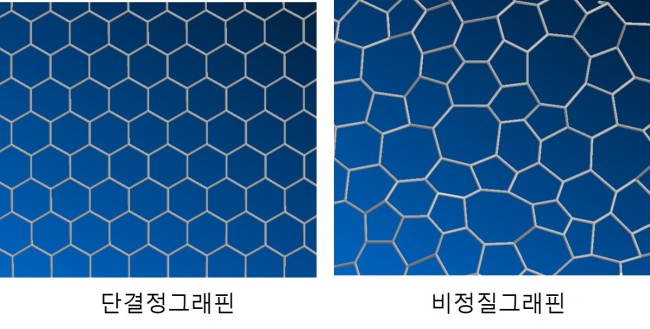Samsung
Samsung develops amorphous graphene synthesis technology
[THE INVESTOR] A joint research team of Samsung Electronics and Sungkyunkwan University in Korea has developed an original technology to create a new material by synthesizing amorphous graphene for the first time in the world, the team announced on Feb. 12.
Graphene, called a “miracle material,” comprises two-dimensional sheets of carbon atoms, and its most common, crystalline form is considered an ideal material for use in flexible and transparent display panels and wearable devices.
Since the characteristics of graphene were discovered in 2004, research on the new substance has been conducted globally. But most of the work had been confined to crystalline forms, which were easier to synthesize.
 |
Diagrams of single-crystal graphene (left), and amorphous graphene (right) |
The Korean team has achieved the world’s first technology to synthesize amorphous graphene, a material with sharply different properties from its crystalline cousin.
This new material has low conductivity, which expands the use of graphene from the electronics industry to others, including desalination.
Samsung Advanced Institute of Technology has teamed up with Sungkyunkwan University’s School of Advanced Materials Sciences and Engineering since 2014 to develop a synthesis technology for a single-crystal graphene, capturing attention from industry and academia alike.
The latest announcement is a follow-up to the previous technological development.
 |
“The latest achievement is significant in that it has expanded the range of two-dimensional materials,” said Whang Dong-mok, professor at Sungkyunkwan University. “It will be possible to discover new areas of application by utilizing the new characteristics of the amorphous material.”
The article authored by the joint team was also published on the website of US journal Science Advances.
By Song Su-hyun/The Korea Herald (song@heraldcorp.com)






![[From the Scene] Gigantic Olive Young store lures young trend-setters in Seongsu](http://res.heraldm.com/phpwas/restmb_idxmake.php?idx=151&simg=/content/image/2024/11/21/20241121050065_0.jpg)

